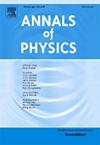Path-integral formulation of truncated Wigner approximation for bosonic Markovian open quantum systems
IF 3
3区 物理与天体物理
Q2 PHYSICS, MULTIDISCIPLINARY
引用次数: 0
Abstract
The truncated Wigner approximation (TWA) enables us to investigate bosonic quantum many-body dynamics, including open quantum systems described by the Gorini-Kossakowski-Sudarshan-Lindblad (GKSL) equation. In the TWA, the Weyl-Wigner transformation, a way of mapping from quantum-mechanical operators to -numbers, of the GKSL equation leads to the Fokker-Planck equation, which we calculate by reducing it to the corresponding stochastic differential equations. However, the Fokker-Planck equation is not always reduced to the stochastic differential equations depending on details of jump operators. In this work, we clarify the condition for obtaining the stochastic differential equations from the Fokker-Planck equation and derive analytical expressions of these equations for a system with an arbitrary Hamiltonian with jump operators that do not couple different states. This result leads to remarkable simplification of the complicated calculations required in the conventional procedures of the TWA. In the course of the derivation, we formulate the GKSL equation by using the path-integral representation based on the Weyl-Wigner transformation, which gives us a clear interpretation of the relation between the TWA and quantum fluctuations and allows us to calculate the non-equal time correlation functions in the TWA. In the benchmark calculations, we numerically confirm that the relaxation dynamics of physical quantities including the non-equal time correlation functions obtained in our formulation agrees well with the exact ones in the numerically solvable models. Since our formulation is widely applicable to bosonic systems such as the Bose-Hubbard model, it facilitates studies of the open quantum many-body phenomenon.
玻色子马尔可夫开放量子系统截断Wigner近似的路径积分公式
截断Wigner近似(TWA)使我们能够研究玻色子量子多体动力学,包括由gorini - kossakowski - sudarshanlindblad (GKSL)方程描述的开放量子系统。在TWA中,GKSL方程的Weyl-Wigner变换(一种从量子力学算符到c数的映射方式)导致了Fokker-Planck方程,我们通过将其简化为相应的随机微分方程来计算Fokker-Planck方程。然而,根据跳跃算子的细节,Fokker-Planck方程并不总是被简化为随机微分方程。本文阐明了从Fokker-Planck方程得到随机微分方程的条件,并推导了具有任意哈密顿算子且不耦合不同状态的系统的随机微分方程的解析表达式。这一结果大大简化了TWA常规程序中复杂的计算。在推导过程中,我们采用基于Weyl-Wigner变换的路径积分表示来表述GKSL方程,从而清晰地解释了TWA与量子涨落之间的关系,并使我们能够计算TWA中的非等时间相关函数。在基准计算中,我们数值证实了公式中得到的物理量(包括非等时间相关函数)的松弛动力学与数值可解模型中的精确松弛动力学符合得很好。由于我们的公式广泛适用于玻色子系统,如玻色-哈伯德模型,它有助于研究开放量子多体现象。
本文章由计算机程序翻译,如有差异,请以英文原文为准。
求助全文
约1分钟内获得全文
求助全文
来源期刊

Annals of Physics
物理-物理:综合
CiteScore
5.30
自引率
3.30%
发文量
211
审稿时长
47 days
期刊介绍:
Annals of Physics presents original work in all areas of basic theoretic physics research. Ideas are developed and fully explored, and thorough treatment is given to first principles and ultimate applications. Annals of Physics emphasizes clarity and intelligibility in the articles it publishes, thus making them as accessible as possible. Readers familiar with recent developments in the field are provided with sufficient detail and background to follow the arguments and understand their significance.
The Editors of the journal cover all fields of theoretical physics. Articles published in the journal are typically longer than 20 pages.
 求助内容:
求助内容: 应助结果提醒方式:
应助结果提醒方式:


